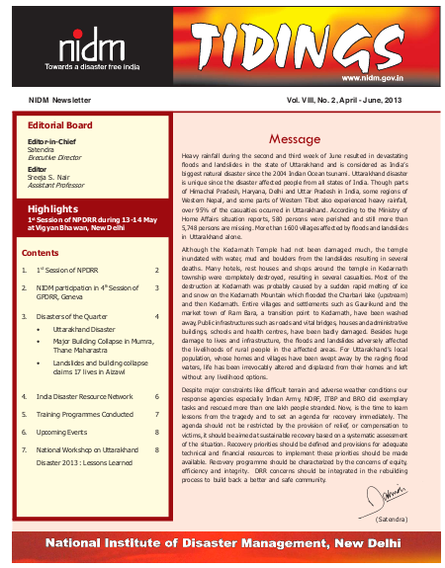
Heavy rainfall during the second and third week of June resulted in devastating floods and landslides in the state of Uttarakhand and is considered as India’s biggest natural disaster since the 2004 Indian Ocean tsunami. Uttarakhand disaster is unique since the disaster affected people from all states of India. Though parts of Himachal Pradesh, Haryana, Delhi and Uttar Pradesh in India, some regions of Western Nepal, and some parts of Western Tibet also experienced heavy rainfall, over 95% of the casualties occurred in Uttarakhand. According to the Ministry of Home Affairs situation reports, 580 persons were perished and still more than 5,748 persons are missing. More than 1600 villages affected by floods and landslides in Uttarakhand alone. Although the Kedarnath Temple had not been damaged much, the temple inundated with water, mud and boulders from the landslides resulting in several deaths. Many hotels, rest houses and shops around the temple in Kedarnath township were completely destroyed, resulting in several casualties. Most of the destruction at Kedarnath was probably caused by a sudden rapid melting of ice and snow on the Kedarnath Mountain which flooded the Charbari lake (upstream) and then Kedarnath. Entire villages and settlements such as Gaurikund and the market town of Ram Bara, a transition point to Kedarnath, have been washed away, Public infrastructures such as roads and vital bridges, houses and administrative buildings, schools and health centres, have been badly damaged. Besides huge damage to lives and infrastructure, the floods and landslides adversely affected the livelihoods of rural people in the affected areas. For Uttarakhand’s local population, whose homes and villages have been swept away by the raging flood waters, life has been irrevocably altered and displaced from their homes and left without any livelihood options. Despite major constraints like difficult terrain and adverse weather conditions our response agencies especially Indian Army, NDRF, ITBP and BRO did exemplary tasks and rescued more than one lakh people stranded. Now, is the time to learn lessons from the tragedy and to set an agenda for recovery immediately. The agenda should not be restricted by the provision of relief, or compensation to victims, it should be aimed at sustainable recovery based on a systematic assessment of the situation. Recovery priorities should be defined and provisions for adequate technical and financial resources to implement these priorities should be made available. Recovery programme should be characterized by the concerns of equity, efficiency and integrity. DRR concerns should be integrated in the rebuilding process to build back a better and safe community.